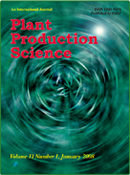6 巻, 1 号
選択された号の論文の14件中1~14を表示しています
- |<
- <
- 1
- >
- >|
Review
-
Synergy of Remote Sensing and Modeling for Estimating Ecophysiological Processes in Plant Production2003 年 6 巻 1 号 p. 3-16
発行日: 2003年
公開日: 2004/04/28
PDF形式でダウンロード (1672K)
Crop Physiology and Ecology
-
2003 年 6 巻 1 号 p. 17-23
発行日: 2003年
公開日: 2004/04/28
PDF形式でダウンロード (1240K) -
2003 年 6 巻 1 号 p. 24-27
発行日: 2003年
公開日: 2004/04/28
PDF形式でダウンロード (498K) -
2003 年 6 巻 1 号 p. 28-35
発行日: 2003年
公開日: 2004/04/28
PDF形式でダウンロード (647K) -
2003 年 6 巻 1 号 p. 36-42
発行日: 2003年
公開日: 2004/04/28
PDF形式でダウンロード (751K) -
2003 年 6 巻 1 号 p. 43-49
発行日: 2003年
公開日: 2004/04/28
PDF形式でダウンロード (874K)
Short Report
-
2003 年 6 巻 1 号 p. 50-51
発行日: 2003年
公開日: 2004/04/28
PDF形式でダウンロード (127K)
Cell and Molecular Biology
-
2003 年 6 巻 1 号 p. 52-58
発行日: 2003年
公開日: 2004/04/28
PDF形式でダウンロード (552K)
Genetic Resources Evaluation
-
2003 年 6 巻 1 号 p. 59-64
発行日: 2003年
公開日: 2004/04/28
PDF形式でダウンロード (423K) -
2003 年 6 巻 1 号 p. 65-73
発行日: 2003年
公開日: 2004/04/28
PDF形式でダウンロード (659K)
Agronomy
-
2003 年 6 巻 1 号 p. 74-82
発行日: 2003年
公開日: 2004/04/28
PDF形式でダウンロード (775K) -
2003 年 6 巻 1 号 p. 83-89
発行日: 2003年
公開日: 2004/04/28
PDF形式でダウンロード (3342K) -
2003 年 6 巻 1 号 p. 90-94
発行日: 2003年
公開日: 2004/04/28
PDF形式でダウンロード (549K) -
2003 年 6 巻 1 号 p. 95-102
発行日: 2003年
公開日: 2004/04/28
PDF形式でダウンロード (586K)
- |<
- <
- 1
- >
- >|
